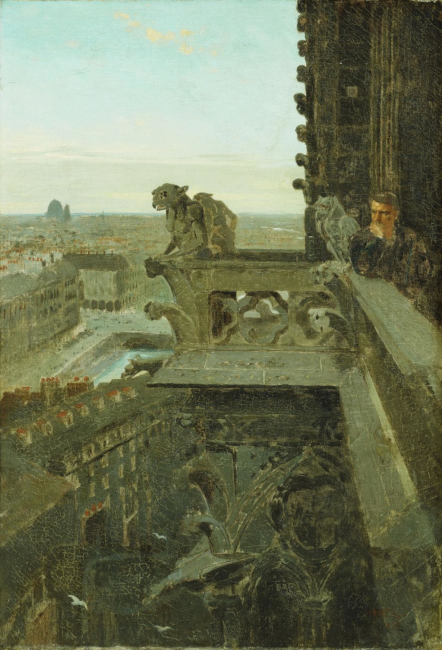We went to see the Cathedral of Notre Dame. We had heard of it before. It surprises me sometimes to think how much we do know and how intelligent we are. We recognized the brown old Gothic pile in a moment; it was like the pictures. We stood at a little distance and changed from one point of observation to another and gazed long at its lofty square towers and its rich front, clustered thick with stony, mutilated saints who had been looking calmly down from their perches for ages. The Patriarch of Jerusalem stood under them in the old days of chivalry and romance, and preached the third Crusade, more than six hundred years ago; and since that day they have stood there and looked quietly down upon the most thrilling scenes, the grandest pageants, the most extraordinary spectacles that have grieved or delighted Paris. These battered and broken-nosed old fellows saw many and many a cavalcade of mail-clad knights come marching home from Holy Land; they heard the bells above them toll the signal for the St. Bartholomew’s Massacre, and they saw the slaughter that followed; later they saw the Reign of Terror, the carnage of the Revolution, the overthrow of a king, the coronation of two Napoleons, the christening of the young prince that lords it over a regiment of servants in the Tuileries to-day—and they may possibly continue to stand there until they see the Napoleon dynasty swept away and the banners of a great republic floating above its ruins. I wish these old parties could speak. They could tell a tale worth the listening to.
They say that a pagan temple stood where Notre Dame now stands, in the old Roman days, eighteen or twenty centuries ago—remains of it are still preserved in Paris; and that a Christian church took its place about A.D. 300; another took the place of that in A.D. 500; and that the foundations of the present cathedral were laid about A.D. 1100. The ground ought to be measurably sacred by this time, one would think. One portion of this noble old edifice is suggestive of the quaint fashions of ancient times. It was built by Jean Sans-Peur, Duke of Burgundy, to set his conscience at rest—he had assassinated the Duke of Orleans. Alas! Those good old times are gone when a murderer could wipe the stain from his name and soothe his troubles to sleep simply by getting out his bricks and mortar and building an addition to a church.
The portals of the great western front are bisected by square pillars. They took the central one away in 1852, on the occasion of thanksgivings for the reinstitution of the presidential power—but precious soon they had occasion to reconsider that motion and put it back again! And they did.
We loitered through the grand aisles for an hour or two, staring up at the rich stained-glass windows embellished with blue and yellow and crimson saints and martyrs, and trying to admire the numberless great pictures in the chapels, and then we were admitted to the sacristy and shown the magnificent robes which the Pope wore when he crowned Napoleon I; a wagon-load of solid gold and silver utensils used in the great public processions and ceremonies of the church; some nails of the true cross, a fragment of the cross itself, a part of the crown of thorns. We had already seen a large piece of the true cross in a church in the Azores, but no nails. They showed us likewise the bloody robe which that archbishop of Paris wore who exposed his sacred person and braved the wrath of the insurgents of 1848, to mount the barricades and hold aloft the olive branch of peace in the hope of stopping the slaughter. His noble effort cost him his life. He was shot dead. They showed us a cast of his face taken after death, the bullet that killed him, and the two vertebrae in which it lodged. These people have a somewhat singular taste in the matter of relics. Ferguson told us that the silver cross which the good archbishop wore at his girdle was seized and thrown into the Seine, where it lay embedded in the mud for fifteen years, and then an angel appeared to a priest and told him where to dive for it; he did dive for it and got it, and now it is there on exhibition at Notre Dame, to be inspected by anybody who feels an interest in inanimate objects of miraculous intervention.
(Innocents Abroad)
Cathedral of Notre Dame
scott
1 December 2021
© 2025 Twain's Geography, All rights reserved.